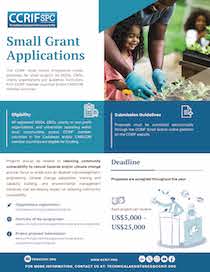Grand Cayman, Cayman Islands, October 1, 2020. CCRIF SPC has launched its newest parametric insurance product, which has been developed for the electric utility sector in the Caribbean. According to CCRIF CEO, Mr. Isaac Anthony, “The development of this product is part of the scaling-up plans of CCRIF, which has as one area of focus the expansion of the Facility’s product offerings, an example of which is to address the needs of the electric utility sector in the Caribbean”. By launching this product, CCRIF has expanded coverage to non-sovereigns and to the private sector, as it takes another bold step to grow and diversify its portfolio and membership. CCRIF currently provides parametric insurance coverage for tropical cyclones, earthquakes, excess rainfall, and the fisheries sector to 19 governments in the Caribbean and 3 in Central America.
Mr. Anthony takes this opportunity to express thanks to the Government of Ireland who provided a grant to CCRIF for funding the development of this product. He wishes to reiterate the key role that development partners have played and continue to play in advancing the work of the Facility. In speaking about the product, Executive Director of the Caribbean Electric Utility Services Corporation (CARILEC), Dr. Cletus Bertin, stated that, “The role of electricity in the economic and social life of the region is pivotal. This product is not just for the electric utilities sector. It is for the development of the region in terms of the economic and social life of the people, who are dependent on tourism as well as agri-business, light manufacturing, etc., which are all reliant on the steady supply of electricity. The product speaks to a broader agenda: our ability to bounce back quickly after a disaster and generate economic activity through the provision of electricity to the industrial and commercial sector”.
The parametric insurance product for electric utilities has been first purchased by the Anguilla Electricity Company Limited (ANGLEC) – with the Facility working with other electric utilities in the Caribbean who are expected to join. CCRIF’s ability to develop and offer products to non-sovereigns is based on the fact that, as a segregated portfolio company (SPC), the Facility is able to establish segregated portfolios (SPs) or cells that allow for total segregation of risk and risk management operations (pricing, policy formats etc.) among cells. Under this structure of SPs, CCRIF also is able to provide benefits such as the sharing of operational functions and costs, thereby being able to offer products that cost much less than if each member were to approach the reinsurance market individually. The SP established for public utilities is called the Caribbean Public Utilities SP (“CPU SP”) and joins 4 other SPs in the CCRIF structure.
The electric utilities product aims to limit the financial impact of devastating tropical cyclones by quickly providing financial liquidity to electric utility companies when a policy is triggered. The product will be limited to covering direct damage to the transmission and distribution (T&D) components of the electric power system due to impacts of wind. One of the issues faced by most electric utilities in the Caribbean is the inability to purchase traditional indemnity insurance for overhead T&D systems because of the very limited availability and uneconomical pricing.
Developing a parametric insurance solution for the electric utilities sector is particularly important because of the natural catastrophe risks faced by many Caribbean territories. Transmission and distribution systems are particularly exposed to wind damage from tropical cyclones such as storms and hurricanes. According to Mr. Anthony, “The close relationship between wind speed and overhead T&D system damage created the opportunity for CCRIF to develop a new and innovative parametric insurance product which could be priced much more competitively in the marketplace than traditional indemnity insurance and would present lower basis risk to the insured utilities”. Acting CEO of ANGLEC, Mr. Peter Lamontagne agrees with Mr. Anthony by stating that “ANGLEC was severely impacted by Hurricane Irma in 2017 and almost all of its transmission and distribution network was destroyed costing the company in excess of XCD40 million to restore. At the time the company had XCD16 million in its reserves (a self-insurance fund) and needless to say, all the reserves were used up. There was an urgent need to find an alternative mechanism because of the active hurricane seasons that we are experiencing”.
Economic losses of utility sectors, particularly transmission and distribution systems, after these events also are high, with citizens oftentimes bearing the brunt of the costs through their electricity bills.
The development of the utilities product was undertaken in close collaboration with CARILEC, an association of electric utilities, suppliers, manufacturers and other stakeholder operations in the electricity industry in the Caribbean where 35 of its members are electric utilities. Dr. Bertin has stressed that his organization “… intends to promote the product as a proof of concept so that other utilities can assess the mechanism. The CARILEC Secretariat will continue to work with CCRIF as it continues to reach out to other utilities of CARILEC – both government-owned and investor-owned – to encourage them to sign on to this very useful insurance package”.
The ability to provide quick liquidity is an important feature of parametric insurance considering the urgent need for liquidity after a catastrophe. Parametric insurance products are insurance contracts that make payments based on the intensity of an event (for example, hurricane wind speed, earthquake intensity, volume of rainfall) and the amount of loss calculated in a pre-agreed model caused by these events. Therefore, payouts can be made very quickly – and in the case of CCRIF, within 14 days after a hazard event. This is different from traditional or indemnity insurance that require an on-the-ground assessment of individual losses after an event before a payout can be made.
CCRIF was established in 2007, following the devastating impacts of Hurricane Ivan which resulted in countries such as the Cayman Islands and Grenada suffering economic losses of about 200 per cent of their annual GDP. The quick liquidity that CCRIF is able to provide within 14 days of these devastating events fills a gap that allows governments to begin initial recovery and support the most vulnerable in their populations. CCRIF has demonstrated that catastrophe risk insurance can effectively provide a level of financial protection for countries vulnerable to natural hazards. Since its inception in 2007, CCRIF has made a total of 45 payouts to 14 member governments totalling approximately US$163 million and which have benefitted over 2.5 million persons.
About CCRIF SPC:
CCRIF SPC is a segregated portfolio company, owned, operated and registered in the Caribbean. It limits the financial impact of catastrophic hurricanes, earthquakes and excess rainfall events to Caribbean and Central American governments by quickly providing short-term liquidity when a parametric insurance policy is triggered. It is the world’s first regional fund utilising parametric insurance, giving member governments the unique opportunity to purchase earthquake, hurricane and excess rainfall catastrophe coverage with lowest-possible pricing. CCRIF was developed under the technical leadership of the World Bank and with a grant from the Government of Japan. It was capitalized through contributions to a Multi-Donor Trust Fund (MDTF) by the Government of Canada, the European Union, the World Bank, the governments of the UK and France, the Caribbean Development Bank and the governments of Ireland and Bermuda, as well as through membership fees paid by participating governments. In 2014, an MDTF was established by the World Bank to support the development of CCRIF SPC’s new products for current and potential members and facilitate the entry for Central American countries and additional Caribbean countries. The MDTF currently channels funds from various donors, including: Canada, through Global Affairs Canada; the United States, through the Department of the Treasury; the European Union, through the European Commission, and Germany, through the Federal Ministry for Economic Cooperation and Development and KfW. Additional financing has been provided by the Caribbean Development Bank, with resources provided by Mexico; the Government of Ireland; and the European Union through its Regional Resilience Building Facility managed by the Global Facility for Disaster Reduction and Recovery (GFDRR) and The World Bank.





